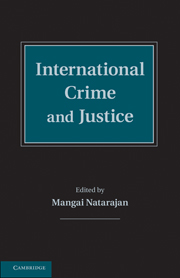Book contents
- Frontmatter
- Contents
- List of Figures
- List of Tables
- List of Contributors
- Foreword
- Preface
- Introduction
- Part I International Criminology
- Part II Law, Punishment, and Crime Control Philosophies of the World
- Part III Transnational Crime
- Part IV Organized Crime and Terrorism
- Part V International crime
- Part VI Delivering International Justice
- Part VII International Cooperation and Criminal Justice
- Part VIII International Research and Crime Statistics
- 60 The U.S. Uniform Crime Reports and the National Crime Victimization Survey
- 61 Highlights of the International Crime Victims Survey
- 62 Crossnational Comparisons Based on Official Statistics of Crime
- 63 The International Self-Report Delinquency Study (ISRD)
- 64 Criminology, Method, and Qualitative Comparative Analysis
- Part IX International research resources
- World Map
- Index
- References
62 - Crossnational Comparisons Based on Official Statistics of Crime
Published online by Cambridge University Press: 05 October 2014
- Frontmatter
- Contents
- List of Figures
- List of Tables
- List of Contributors
- Foreword
- Preface
- Introduction
- Part I International Criminology
- Part II Law, Punishment, and Crime Control Philosophies of the World
- Part III Transnational Crime
- Part IV Organized Crime and Terrorism
- Part V International crime
- Part VI Delivering International Justice
- Part VII International Cooperation and Criminal Justice
- Part VIII International Research and Crime Statistics
- 60 The U.S. Uniform Crime Reports and the National Crime Victimization Survey
- 61 Highlights of the International Crime Victims Survey
- 62 Crossnational Comparisons Based on Official Statistics of Crime
- 63 The International Self-Report Delinquency Study (ISRD)
- 64 Criminology, Method, and Qualitative Comparative Analysis
- Part IX International research resources
- World Map
- Index
- References
Summary
INTRODUCTION
Crossnational comparisons of crime are usually based in two main types of sources: crime statistics and crime surveys. Provided they use the same questionnaire and the same methodology, crime surveys constitute the best source for comparisons. Comparisons based on surveys are described in other sections of this book. This chapter is devoted to crossnational comparisons based on official statistics, which include police, prosecution, conviction, and correctional statistics. Because these statistics measure the reaction to crime and not crime itself, comparisons based on them are usually called comparisons of recorded crime.
BACKGROUND INFORMATION
Theoretically, official statistics allow researchers to compare offences, suspects, and offenders throughout the criminal justice system – from suspects known to the police to offenders imprisoned – as well as sanctions and measures imposed in different countries. However, in practice, such comparisons are often methodologically inappropriate because official statistics are constructed in a different way in each country. This means that, in most cases, crossnational differences in recorded crime rates do not reflect actual differences in the levels of crime.
The main sources for crossnational comparisons of recorded-crime are indicated in another section of this book. We have illustrated this chapter with examples from the European Sourcebook of Crime and Criminal Justice Statistics, the American Sourcebook of Criminal Justice Statistics, the United Nations Surveys on Crime Trends and the Operations of Criminal Justice Systems (UNCTS), and the Council of Europe Annual Penal Statistics (SPACE I).
- Type
- Chapter
- Information
- International Crime and Justice , pp. 471 - 477Publisher: Cambridge University PressPrint publication year: 2010
References
- 1
- Cited by

